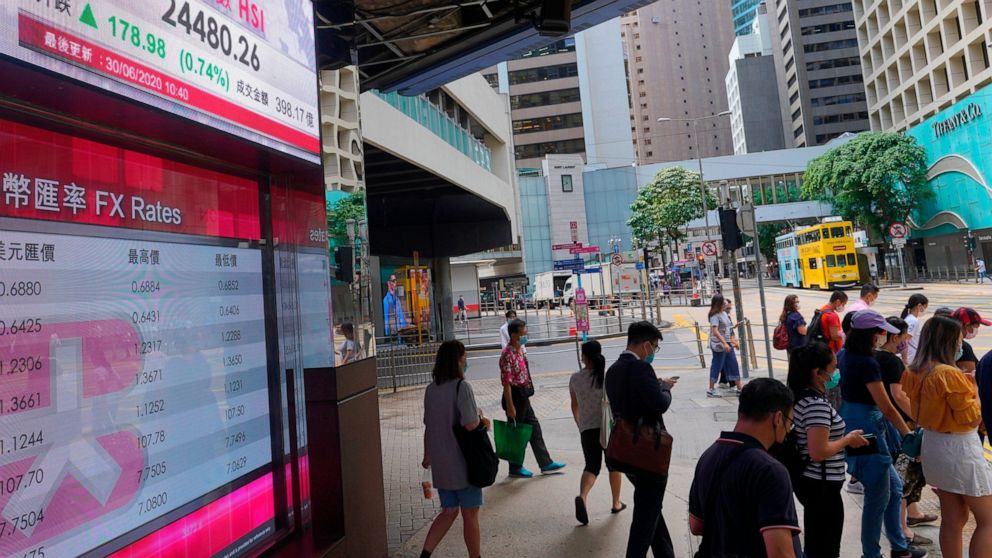Stocks close out best quarter since 1998 with more gains
Wall Street closed out its best quarter since 1998 with more gains Tuesday but still well below the record high it reached in February, before devastating lockdowns were put in place to fight the coronavirus
By
STAN CHOE, ALEX VEIGA and DAMIAN J. TROISE AP Business Writers
June 30, 2020, 8:11 PM
5 min read
5 min read
NEW YORK — Wall Street closed out its best quarter since 1998 with more gains Tuesday but still well below the record high it reached in February, before devastating lockdowns were put in place to fight the coronavirus. The S&P 500 gained 1.5%, bringing its gain for the quarter to nearly 20%. However that came after a wipeout in the first quarter as the economy screeched to a halt and millions of people lost their jobs. The economy remains in a recovering but still fragile state, and moves by Texas and other states to reverse steps to reopen their economies as infections surge have discouraged investors.
THIS IS A BREAKING NEWS UPDATE. AP’s earlier story is below:
Stocks headed higher on Wall Street for the second day in a row Tuesday, a fitting end for a rocking quarter that propelled the U.S. stock market screaming back toward its record heights.
The S&P 500 was up 0.9%, bringing its gain since the end of March to 19.2%. Other stock markets around the world closed mixed, while Treasury yields mostly rose and crude oil gave up a smidgen of its tremendous rebound for the quarter.
The Dow Jones Industrial Average was up 26 points, or 0.1%, to 25,614. It had briefly been down 120 points. The Nasdaq composite gained 1.3%. Small company stocks notched solid gains, driving the Russell 2000 index 1.1% higher.
Technology, health care and financial companies powered much of the market’s broad gains. The buying accelerated after a report showed stronger-than-expected improvement in consumer confidence this month.
“Broadly speaking, the market is reacting to economic data that is better than expected,” said Brent Schutte, chief investment strategist at Northwestern Mutual Wealth Management.
Schutte said the market is being supported by the likelihood that there won’t be a nationwide shutdown again, aggressive monetary policy and hopes for a vaccine sooner rather than later. “The path of least resistance is still two steps forward, one step back,” he said.
The S&P 500 is on pace for its best quarter since 1998, but that’s only after a 20% plunge that marked its worst quarter since the 2008 financial crisis. The vicious whiplash ripped through markets as investors became increasingly hopeful that the economy can pull out of its severe, sudden recession relatively quickly.
The hopes looked prescient after reports during the quarter showed that the job market swung back to growth and retail sales rebounded as governments relaxed lockdown orders meant to slow the spread of the coronavirus.
Stocks built on gains made toward the tail end of the first quarter, when promises of massive amounts of aid from the Federal Reserve and Capitol Hill helped put a floor under the market. Low interest rates generally push investors toward stocks and away from the low payments made by bonds, and the Federal Reserve has pinned short-term interest rates at their record low of nearly zero.
But most of Wall Street says not to expect anything close to a repeat of the rocking second quarter. A rise in coronavirus infections has several states pausing their lifting of restrictions. The surge in confirmed new cases, which has prompted the European Union to bar U.S. travelers from entry, is seeding doubts that the economic recovery can happen as quickly as markets had forecast. Investors are setting prices for stocks now based on where they expect corporate profits to be months into the future.
“It’s a rally built upon stimulus and vaccine optimism,” said David Lyon, global investment specialist at J.P. Morgan Private Bank.
Another factor that’s helped keep markets climbing overall is a sense among traders that even as some states pause reopening or order some businesses shut down again in response to rising new confirmed COVID-19 cases, the economy is on the mend.
“It’s a recognition that the worst of the economic impact is behind us,” he said. “The question is just the pace of the reopening and the return of normalcy. Even though it’s probably going to be slower, it’s still in a positive trajectory.”
Beyond the coronavirus, analysts also point to the upcoming U.S. elections and other risks that could upset markets. If Democrats sweep Capitol Hill and the White House, which many investors see as at least possible, it could mean higher tax rates, which could weaken corporate profits.
The S&P 500 has rallied back to within nearly 9% of its record set in February, after being down nearly 34% in late March. At one point earlier this month, it had climbed as close as 4.5%.
Crude oil has had a similar rebound as stocks through the second quarter, though it’s still well below where it was before the pandemic struck.
A barrel of U.S. crude oil slid 1.1% to $39.27 Tuesday, but it’s still nearly double where it was at the end of the first quarter. It’s also in a different world from April, when prices in one corner of the U.S. crude market briefly went below zero amid worries that collapsing demand would leave nowhere to store all the unused oil. Brent crude oil fell 1.3% to $41.15 a barrel.
The yield on the 10-year Treasury rose to 0.65% from 0.63% late Monday. It too has rallied back from its lows when recession worries were at their height. It set a record low in March when it briefly dipped below 0.50%, according to Tradeweb. The yield tends to move with investors’ expectations for the economy and inflation.
European stocks closed mixed, and Asian markets finished higher.
———
AP Business Writer Yuri Kageyama contributed.
![]()


